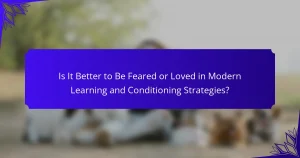Nurturing resilience, empathy, and growth is essential in modern learning environments. Faith with love fosters a supportive atmosphere that enhances emotional safety. Unique empathy strategies build stronger connections among students and educators. Integrating faith-based principles promotes adaptability and collaborative skills, driving both academic performance and personal development.
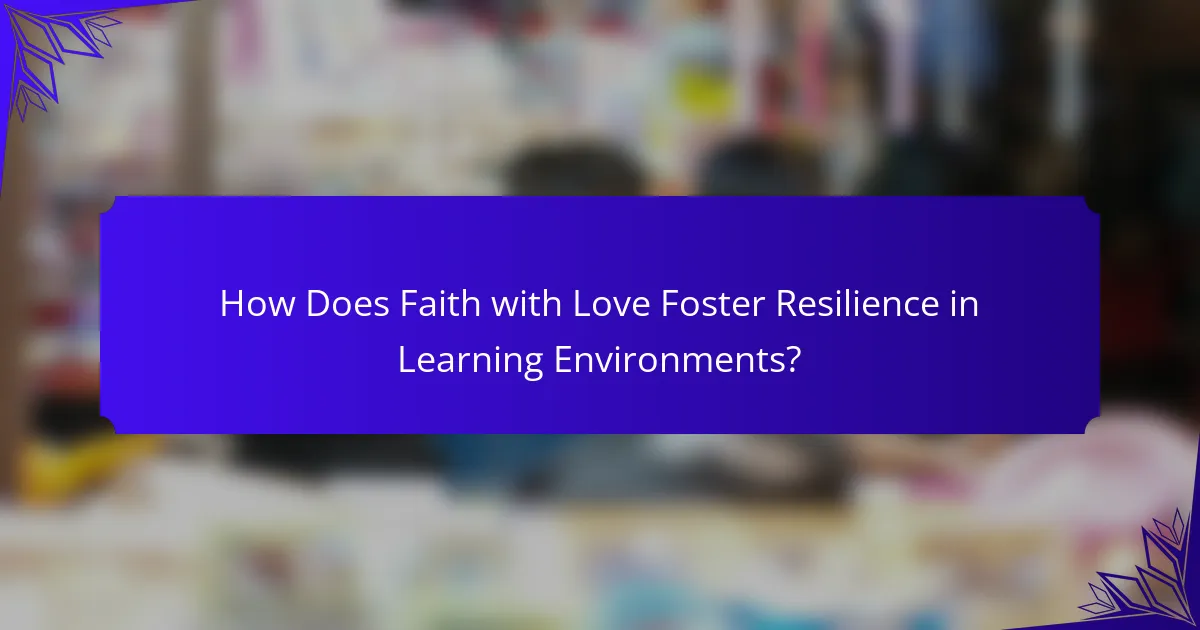
How Does Faith with Love Foster Resilience in Learning Environments?
Faith with love cultivates resilience in learning environments by fostering a supportive atmosphere. This nurturing environment enhances empathy among students, which in turn promotes emotional growth. Research indicates that students who experience love and faith in educational settings show improved academic performance and social skills. The unique attribute of emotional safety created through faith-based initiatives allows learners to engage more deeply, take risks, and recover from setbacks. As a result, resilience becomes a natural outcome of this enriched learning experience.
What are the key principles of resilience in education?
Resilience in education hinges on fostering adaptability, emotional intelligence, and a supportive community. Key principles include cultivating a growth mindset, promoting empathy, and encouraging collaboration. These elements empower students to navigate challenges effectively. Research indicates that resilient learners demonstrate improved academic performance and emotional well-being. By integrating these principles, educators can create nurturing environments that facilitate personal and academic growth.
How can educators cultivate resilience through love and support?
Educators can cultivate resilience through love and support by creating nurturing environments. These environments foster emotional safety, encouraging students to express themselves. Consistent positive reinforcement builds confidence, while empathetic listening strengthens connections. Collaborative activities enhance social skills, promoting teamwork and mutual respect. Furthermore, integrating mindfulness practices helps students manage stress, enhancing their overall resilience.
What strategies enhance student resilience in challenging situations?
Building resilience in students involves integrating supportive strategies that foster emotional strength and adaptability. Encouraging open communication, promoting a growth mindset, and providing emotional support are essential.
1. Open Communication: Establishing a safe environment where students can express their feelings enhances their ability to cope with challenges.
2. Growth Mindset: Teaching students to view challenges as opportunities for learning fosters resilience. This mindset encourages persistence and adaptability.
3. Emotional Support: Providing access to counselling resources and mentorship helps students navigate difficult situations effectively.
4. Collaborative Learning: Engaging students in teamwork cultivates a sense of belonging and shared responsibility, enhancing their resilience.
5. Mindfulness Practices: Incorporating mindfulness techniques into daily routines helps students manage stress and remain focused during challenging times.
What role does community play in building resilience?
Community plays a crucial role in building resilience by providing support, fostering connections, and promoting shared experiences. In modern learning environments, community engagement enhances empathy and growth, enabling individuals to navigate challenges collectively. Research shows that strong community ties improve mental well-being and increase adaptive coping strategies. Furthermore, collaborative learning experiences within a community can lead to greater resilience by allowing individuals to learn from one another’s strengths and perspectives.
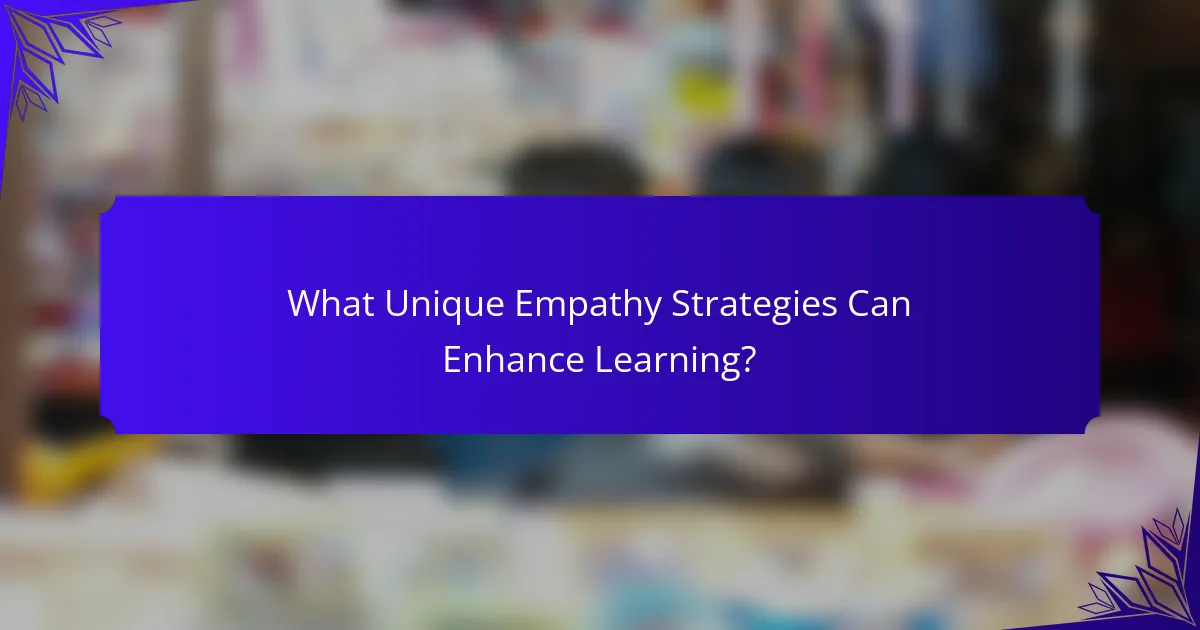
What Unique Empathy Strategies Can Enhance Learning?
Unique empathy strategies enhance learning by fostering stronger connections among students and educators. These strategies include active listening, perspective-taking, and collaborative problem-solving. Active listening allows educators to understand student concerns, while perspective-taking encourages students to appreciate diverse viewpoints. Collaborative problem-solving nurtures teamwork and resilience, essential for growth in modern learning environments. Implementing these strategies cultivates an atmosphere of trust and respect, leading to improved academic outcomes and emotional well-being.
How does empathy influence student-teacher relationships?
Empathy significantly enhances student-teacher relationships by fostering trust and understanding. When teachers demonstrate empathy, students feel valued and supported, which promotes a positive learning environment. This emotional connection encourages open communication, leading to improved academic performance and personal growth. Research indicates that empathetic interactions can boost student engagement and resilience, ultimately shaping a more effective educational experience.
What are effective empathy-building activities for students?
Effective empathy-building activities for students include role-playing, community service projects, and group discussions. These activities foster understanding and connection among peers.
Role-playing allows students to experience different perspectives, enhancing emotional intelligence. Community service projects promote teamwork and compassion, while group discussions encourage open dialogue about feelings and experiences.
Incorporating these activities regularly nurtures resilience and growth, essential attributes in modern learning environments.
How can role-playing enhance empathy in classroom settings?
Role-playing enhances empathy in classroom settings by allowing students to experience different perspectives. This immersive approach fosters emotional understanding and connection among peers. Engaging in role-play activities helps students develop critical thinking and communication skills, promoting resilience in social interactions. Research shows that students who participate in role-playing exercises demonstrate improved empathy scores, indicating a deeper grasp of diverse viewpoints. This method nurtures a supportive learning environment conducive to personal growth and collaborative learning.
What are some innovative approaches to teaching empathy?
Innovative approaches to teaching empathy include experiential learning, storytelling, and role-playing. These methods foster emotional connections and understanding among learners.
Experiential learning engages students through real-life scenarios, allowing them to practice empathy in a safe environment. Storytelling cultivates empathy by sharing diverse perspectives, enhancing emotional resonance. Role-playing enables learners to step into others’ shoes, promoting deeper understanding of different viewpoints.
Integrating these approaches into curricula can significantly enhance emotional intelligence and resilience in students, ultimately contributing to their personal growth and development.
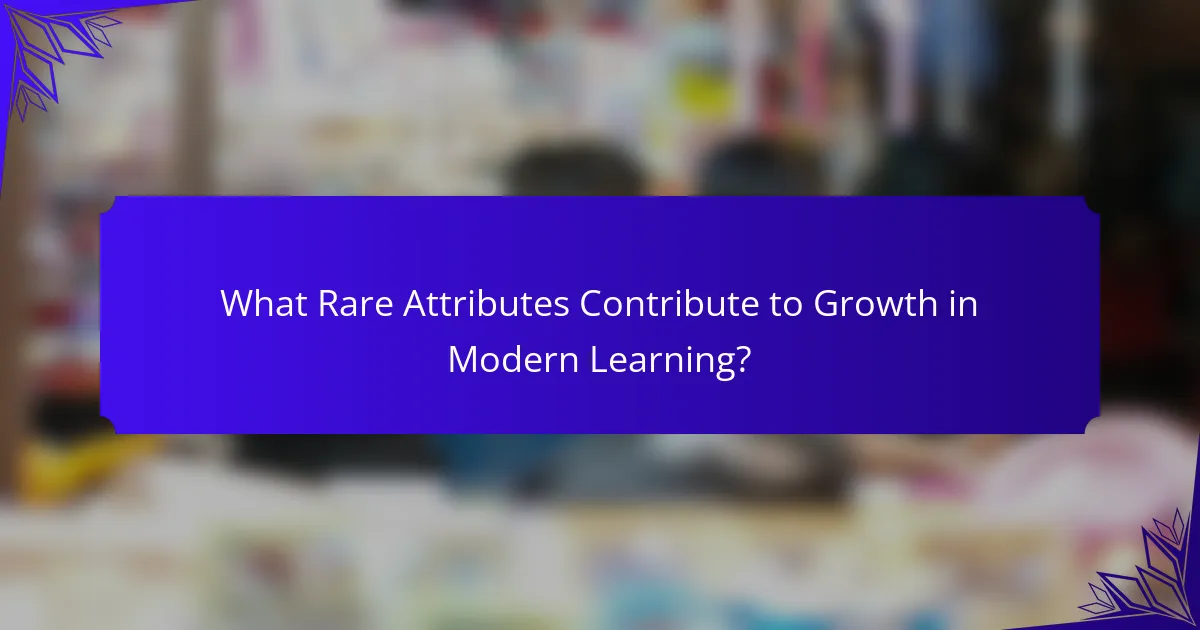
What Rare Attributes Contribute to Growth in Modern Learning?
Rare attributes that contribute to growth in modern learning include adaptability, emotional intelligence, and collaborative skills. These attributes foster resilience and empathy, essential for thriving in diverse educational environments. Adaptability allows learners to navigate change effectively, while emotional intelligence enhances interpersonal relationships. Collaborative skills promote teamwork and collective problem-solving, driving innovation and deeper understanding.
How can personalized learning plans drive growth?
Personalized learning plans can significantly drive growth by tailoring education to individual needs. These plans foster resilience by encouraging students to set personal goals and reflect on their learning journey. Empathy is nurtured as educators understand diverse backgrounds and challenges, creating supportive environments. Growth is measured through personalized metrics, ensuring each student progresses at their own pace.
What are the benefits of integrating technology for growth?
Integrating technology fosters growth by enhancing resilience and empathy in learning environments. It provides access to diverse resources, promotes collaboration, and enables personalized learning experiences. These benefits lead to improved student engagement and academic performance. Technology also encourages adaptability, preparing learners for future challenges.
How can adaptive learning tools support individual growth?
Adaptive learning tools enhance individual growth by personalizing educational experiences. They adjust to each learner’s pace, strengths, and weaknesses, fostering resilience and empathy. These tools provide real-time feedback, enabling students to reflect on their progress and adapt their strategies. As a result, learners develop a growth mindset, essential for thriving in modern environments. Data shows that personalized learning can lead to a 30% increase in student engagement, highlighting the unique attribute of adaptability in these tools.
What are the challenges of fostering growth in diverse classrooms?
Fostering growth in diverse classrooms presents challenges such as varied learning styles, cultural differences, and resource allocation. These factors can hinder effective communication and engagement. Teachers must develop tailored strategies to create inclusive environments that nurture resilience and empathy. Addressing these challenges requires ongoing professional development and collaboration among educators.
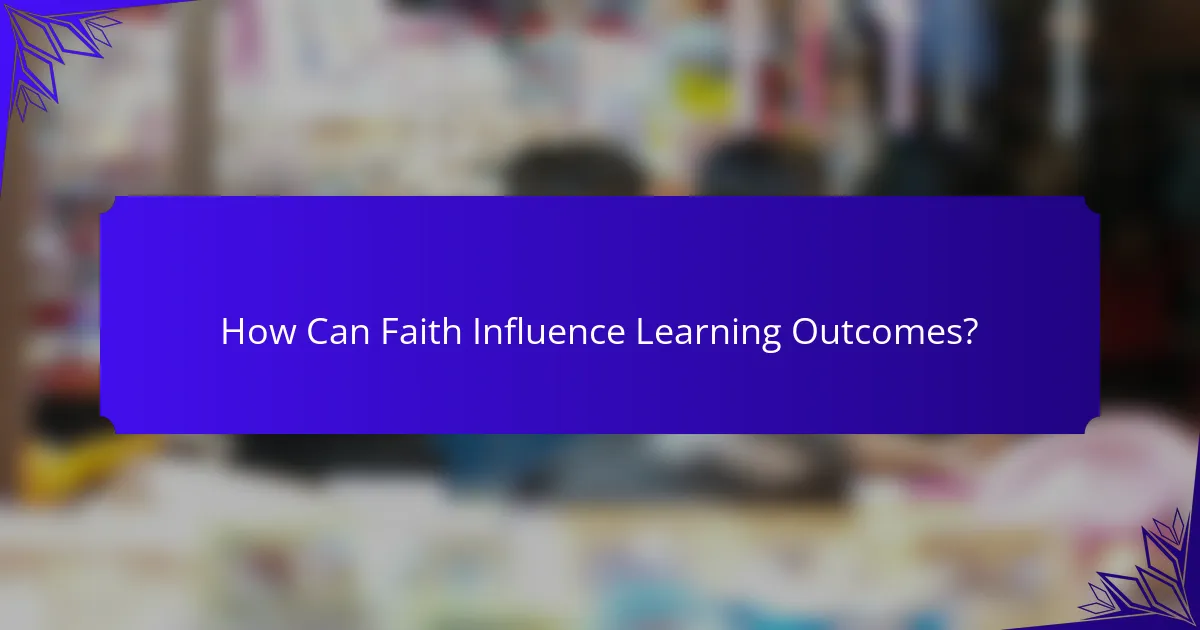
How Can Faith Influence Learning Outcomes?
Faith significantly enhances learning outcomes by fostering resilience, empathy, and personal growth. In educational settings, faith can create a supportive environment that encourages students to persevere through challenges. Research indicates that students with a strong sense of purpose, often derived from their faith, demonstrate improved academic performance and emotional well-being. This connection between faith and learning cultivates empathy, allowing students to understand diverse perspectives and collaborate effectively. Ultimately, integrating faith into learning promotes a holistic approach that nurtures both intellectual and emotional development.
What impact does a faith-based approach have on student motivation?
A faith-based approach significantly enhances student motivation by fostering a sense of belonging and purpose. This method cultivates resilience, empathy, and personal growth, aligning educational experiences with values. Research indicates that students in faith-oriented environments often exhibit higher engagement levels, improved academic performance, and stronger interpersonal relationships. These attributes contribute to a supportive atmosphere that encourages perseverance and a positive mindset, ultimately leading to enhanced educational outcomes.
How can faith principles be integrated into modern curricula?
Integrating faith principles into modern curricula fosters resilience, empathy, and growth. This approach encourages students to develop a strong moral foundation while enhancing their social and emotional skills.
Incorporating faith principles can be achieved through various methods. Educators can emphasize values such as compassion, integrity, and service in classroom discussions. Additionally, project-based learning that involves community service can reinforce these principles in real-world contexts.
Another effective strategy is the inclusion of literature and case studies that reflect diverse faith perspectives. This exposes students to different worldviews, promoting empathy and understanding. Schools can also host interfaith dialogues, encouraging open conversations about beliefs and values.
Finally, integrating mindfulness practices grounded in faith can improve students’ emotional well-being. Techniques such as meditation or reflective journaling can help students process their experiences and develop resilience.
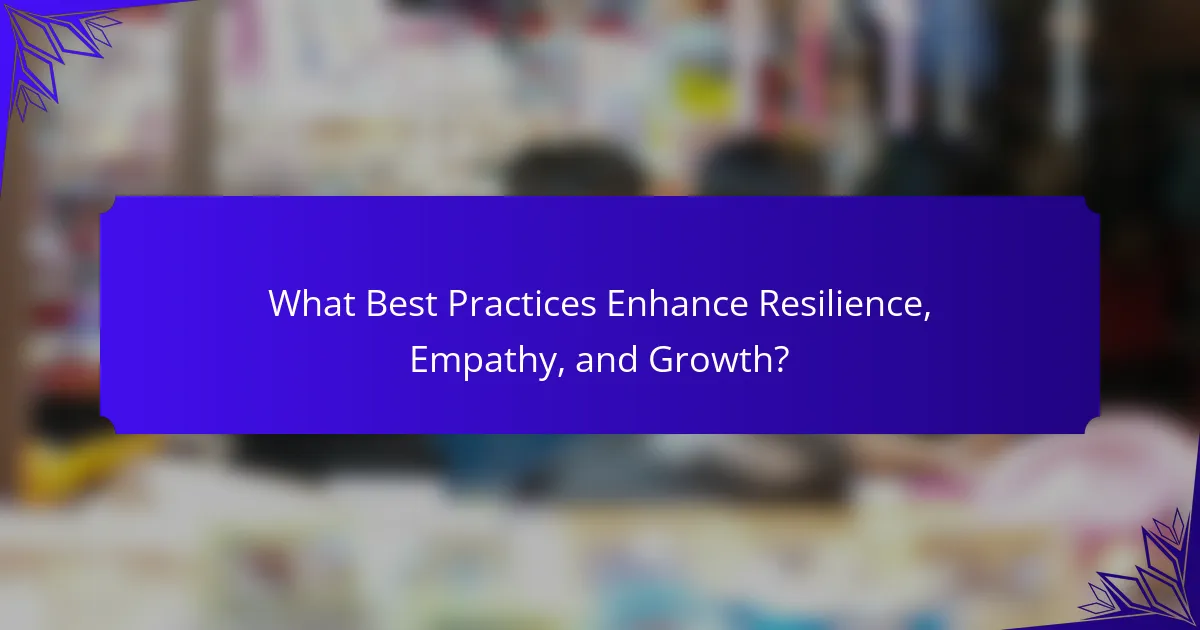
What Best Practices Enhance Resilience, Empathy, and Growth?
To enhance resilience, empathy, and growth, integrate faith-based principles into modern learning environments. These practices foster a supportive atmosphere, encouraging collaboration and understanding.
1. Cultivate a growth mindset: Encourage learners to view challenges as opportunities for development.
2. Promote active listening: Teach students to engage fully with others, enhancing empathy and communication.
3. Implement reflective practices: Encourage regular reflection on experiences to build resilience and self-awareness.
4. Foster community engagement: Involve learners in community service to enhance empathy and social responsibility.
5. Encourage mentorship: Pair students with mentors to provide guidance and support, facilitating personal growth.
What common mistakes should educators avoid?
Educators should avoid common mistakes that hinder resilience and empathy in learning environments. Focusing solely on standardized testing can stifle creativity and growth. Neglecting to foster a supportive community undermines student engagement. Additionally, failing to adapt teaching methods to diverse learning styles limits student potential. Lastly, overlooking the importance of emotional intelligence can lead to a lack of empathy among students.
How can educators optimize their teaching methods for better outcomes?
Educators can optimize teaching methods by fostering resilience, empathy, and growth. Integrating emotional intelligence into curricula enhances student engagement and learning outcomes.
Promoting collaborative learning environments encourages peer support, which builds resilience. Educators should implement strategies like group projects and discussions to facilitate this.
Incorporating feedback mechanisms allows students to reflect on their learning processes. Regular assessments can help identify areas for improvement and encourage growth.
Utilizing diverse teaching methods caters to various learning styles, enhancing empathy among students. This approach ensures that all students feel valued and understood, promoting a positive classroom atmosphere.
What expert insights can guide the nurturing of resilience and empathy?
Expert insights emphasize that nurturing resilience and empathy in learning environments involves fostering supportive relationships, promoting emotional intelligence, and encouraging adaptive coping strategies. Effective mentorship and collaborative learning enhance these attributes, enabling students to thrive in challenges. Research shows that environments prioritising emotional well-being lead to improved academic performance and interpersonal skills. Integrating mindfulness practices can further cultivate resilience, allowing learners to manage stress and develop empathy towards others.


